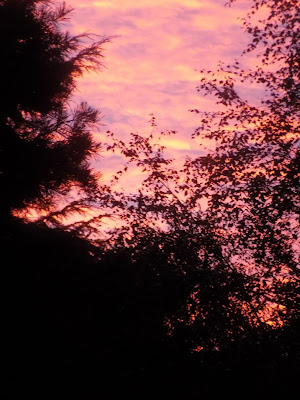Dried Pine Sap: can be picked off and chewed to help with a sore throat or cold. It is also nicely flammable; so once lit can extend your initial fire starting time and can be used to get damp'ish tinder/kindling dried and properly burning.
Mattress Building Or Shelter Building: because of their flat, wide-spreading shape, pine boughs make a fantastic and quick to build mattress or walls on your debris shelter. Their springy texture can nicely build your mattress/bed well up off the ground. Especially useful on snow covered ground or damp ground. A small hatchet is best for lopping these boughs. You obviously have major environmental and leave no trace issues here to consider. Least impactful is to gather boughs from a fallen pine tree; however the boughs still need to be green and living/semi-living - you do not want brown dead needles shedding all night into your gear/clothes/hair!
Inner Bark: the next five photos show the process for gathering the edible inner white bark; which can be eaten raw, boiled, fried, or dried and ground into flour. Only one small bark section from each pine tree as this is obviously impactful on the tree. The outer bark cannot be eaten.
Photo 1
Photo 2
Photo 3
Photo 4
Photo 5
Pine Tree Root: one of the best natural cordages you will ever find. Quick and simple.
Pine roots are shallow and spread out in a circular pattern, so scrabble in the soil with your hands around a pine trunk until you find a root. Carefully expose the root until you have as much as you need. It needs to be exposed and carefully dug out, as if you pull it will break.
To be environmentally conscious two roots per tree max is all you should take; then cover back up any of your diggings.
A clove hitch is a good knot for pine root.
Experiment with your cordage roots; roots too slim and they will snap, roots too chunky will not be flexible enough.
Soft Pine Sap: is antiseptic, astringent (slows bleeding), anti-inflammatory and antibacterial. Apply pine sap to wounds/cuts, once you have cleaned them with clean/boiled/sterilised water. Apply generously. Also good to use on eczema and skin rashes.
Pine Tea: tasty and full of vitamin c, in fact has four to five times the vitamin c of a freshly squeezed orange. Also high in vitamin a (vision, immune system, reproduction). Acts as a decongestant, and when cooled - an antiseptic wash. For the full taste and health benefits have your water just below boiling temperature when adding the needles.
Here Is Another Good Blog On The Pine TreeMattress Building Or Shelter Building: because of their flat, wide-spreading shape, pine boughs make a fantastic and quick to build mattress or walls on your debris shelter. Their springy texture can nicely build your mattress/bed well up off the ground. Especially useful on snow covered ground or damp ground. A small hatchet is best for lopping these boughs. You obviously have major environmental and leave no trace issues here to consider. Least impactful is to gather boughs from a fallen pine tree; however the boughs still need to be green and living/semi-living - you do not want brown dead needles shedding all night into your gear/clothes/hair!
Inner Bark: the next five photos show the process for gathering the edible inner white bark; which can be eaten raw, boiled, fried, or dried and ground into flour. Only one small bark section from each pine tree as this is obviously impactful on the tree. The outer bark cannot be eaten.
Photo 1
Photo 2
Photo 3
Photo 4
Photo 5
Pine Tree Root: one of the best natural cordages you will ever find. Quick and simple.
Pine roots are shallow and spread out in a circular pattern, so scrabble in the soil with your hands around a pine trunk until you find a root. Carefully expose the root until you have as much as you need. It needs to be exposed and carefully dug out, as if you pull it will break.
To be environmentally conscious two roots per tree max is all you should take; then cover back up any of your diggings.
A clove hitch is a good knot for pine root.
Experiment with your cordage roots; roots too slim and they will snap, roots too chunky will not be flexible enough.
Soft Pine Sap: is antiseptic, astringent (slows bleeding), anti-inflammatory and antibacterial. Apply pine sap to wounds/cuts, once you have cleaned them with clean/boiled/sterilised water. Apply generously. Also good to use on eczema and skin rashes.
Pine Tea: tasty and full of vitamin c, in fact has four to five times the vitamin c of a freshly squeezed orange. Also high in vitamin a (vision, immune system, reproduction). Acts as a decongestant, and when cooled - an antiseptic wash. For the full taste and health benefits have your water just below boiling temperature when adding the needles.
Click Here To See Our Bushcraft Skills, Forest Skills And Survival Skills Training Courses

































































